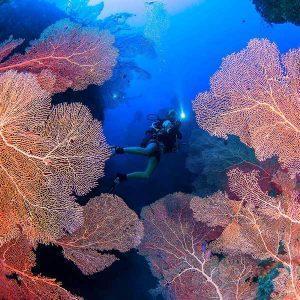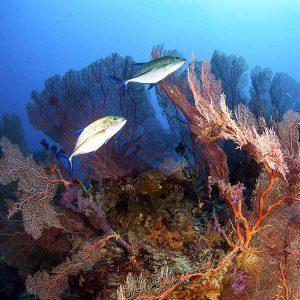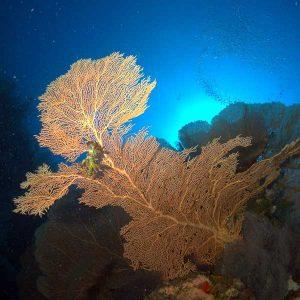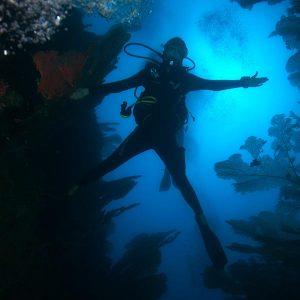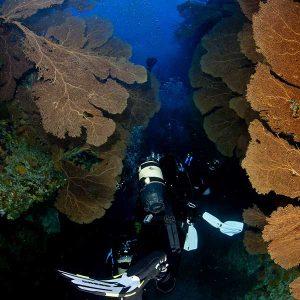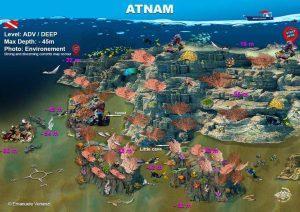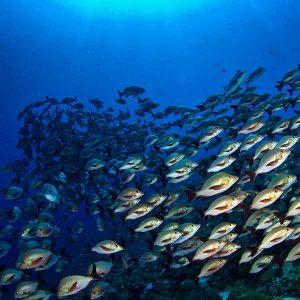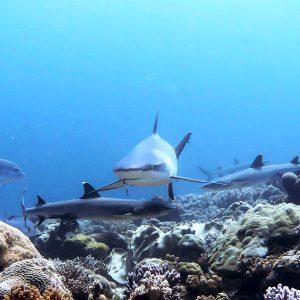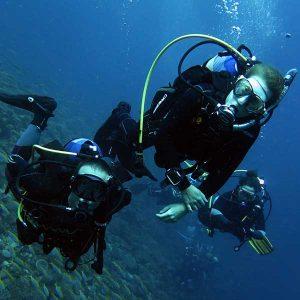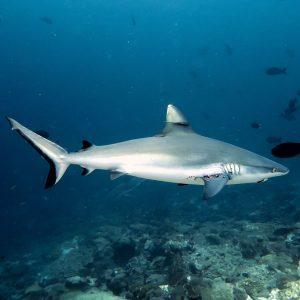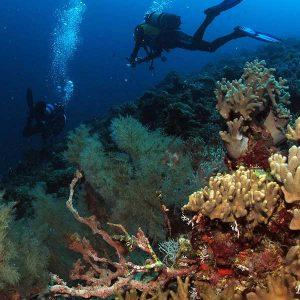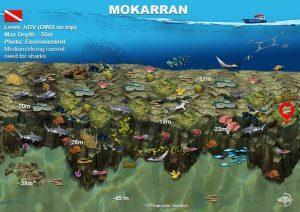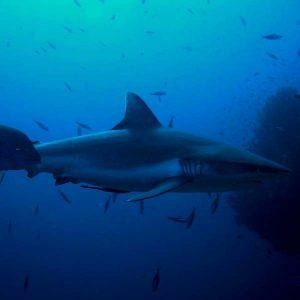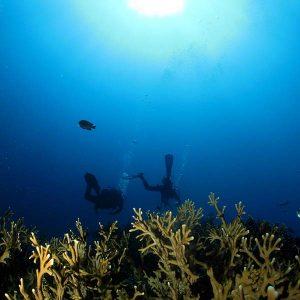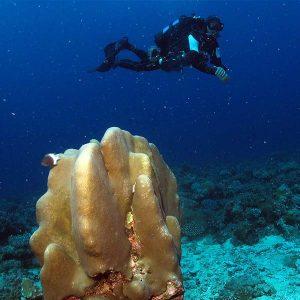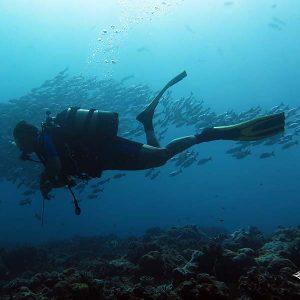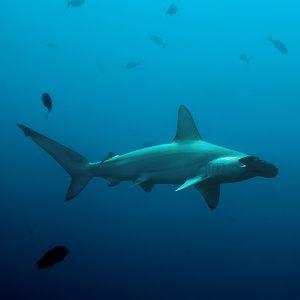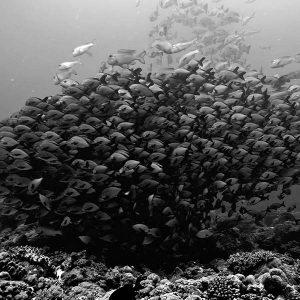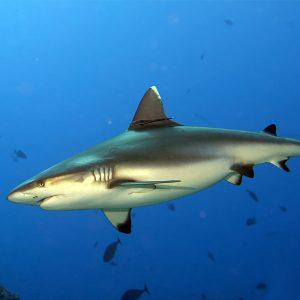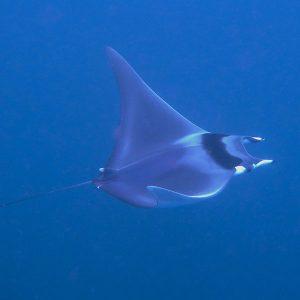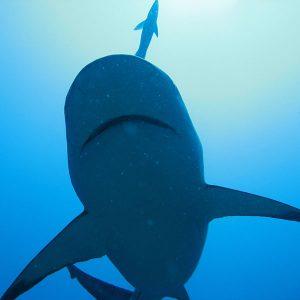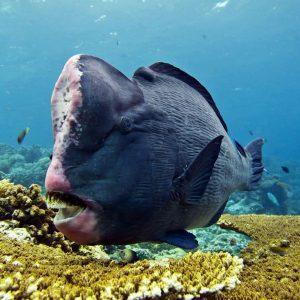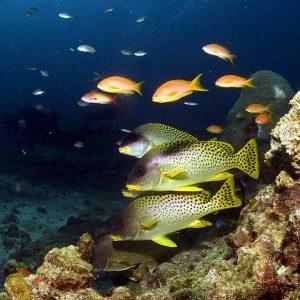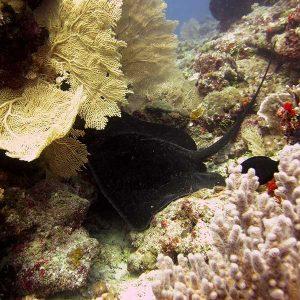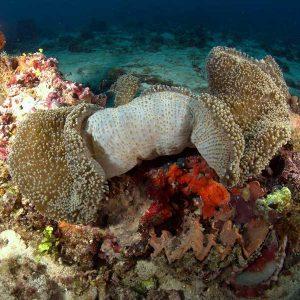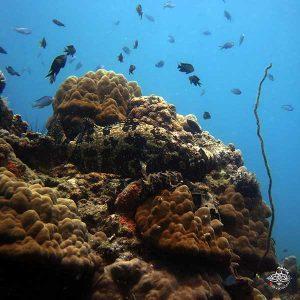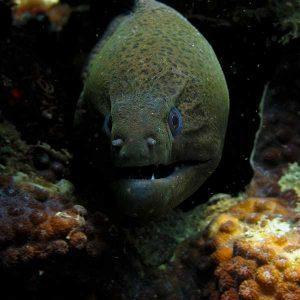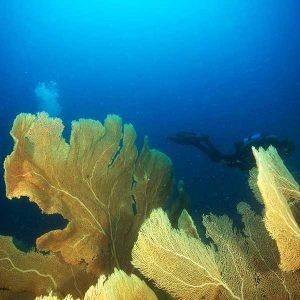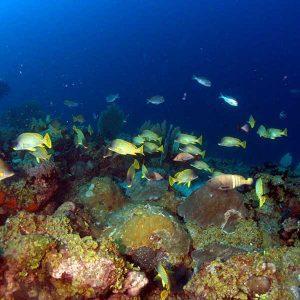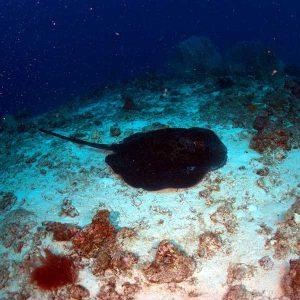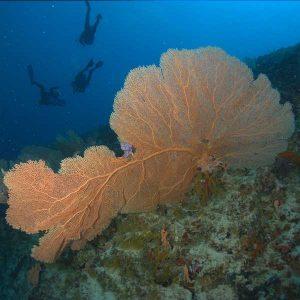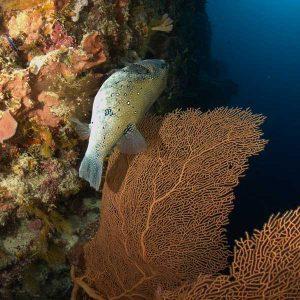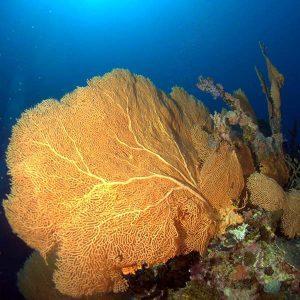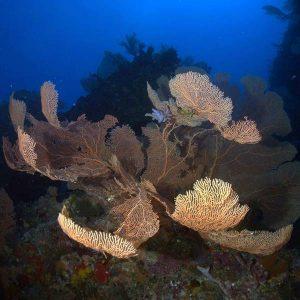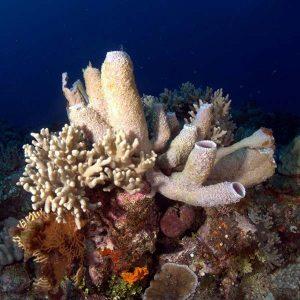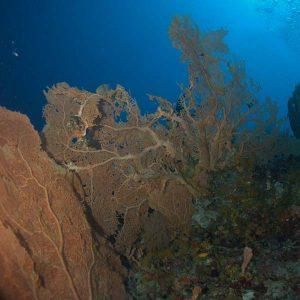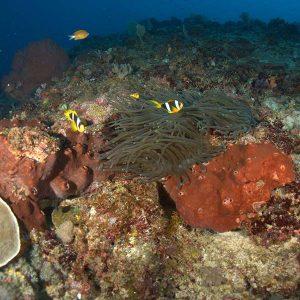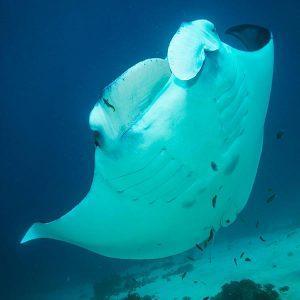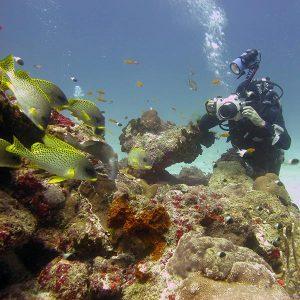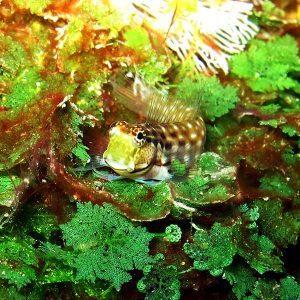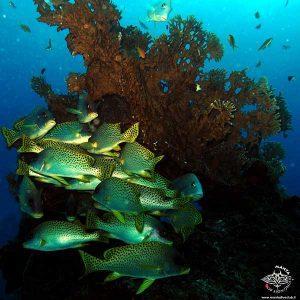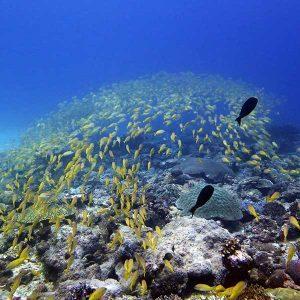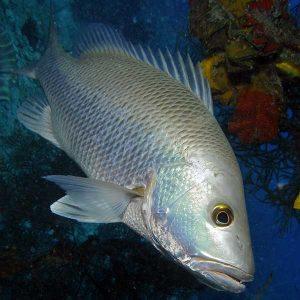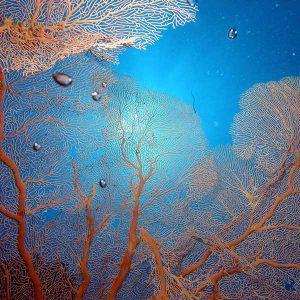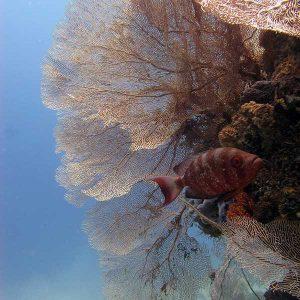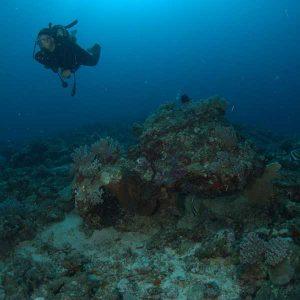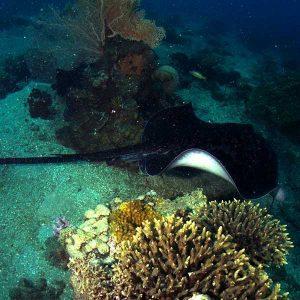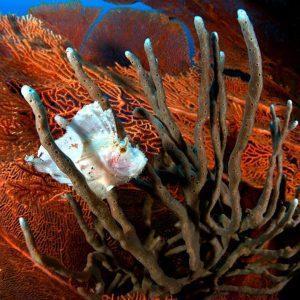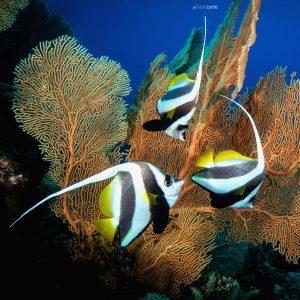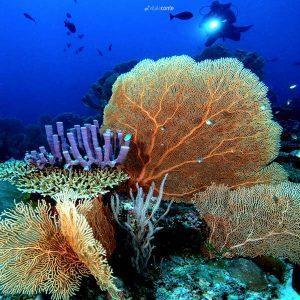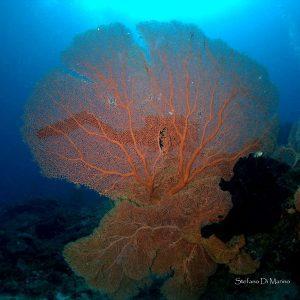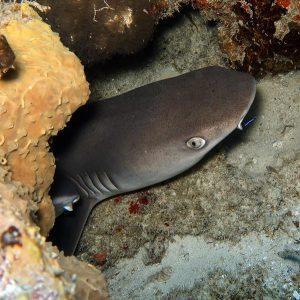
We have the opportunity to meet large fish species, especially on the wall where the Mozambique Channel begins, in other filterers or large schools (shoals) of fish.
You can enjoy most of the walls of this archipelago.
There are reefs covered by such bright corals you can hardly believe it.
Since it is a submerged coral reef, the currents in the open sea maintain a temperature that guarantees the life of corals.
Do you know what a coral reef in good condition stands for?
It means food, nursery, shelter. In one word, LIFE!
We use to go diving twice in the morning, one offshore dive and one closer to the coast, in order to give the opportunity to appreciate this beautiful environment in all its forms.
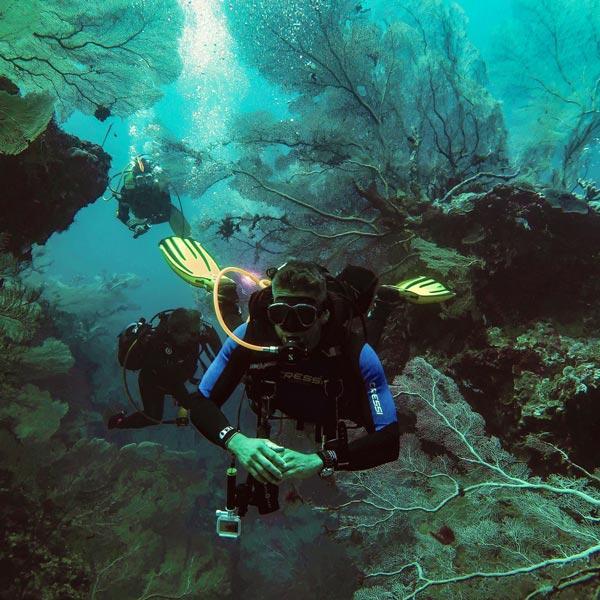

Can you read it starting from the bottom? It’s Manta!
It was discovered by chance by Roberto Casiraghi, one of the first founders of Manta Diving, in 1999. It is one of the most amazing dives in this part of the Indian Ocean.
Its peculiar characteristic is the spectacular shape of the seafloor. About 11 miles from the coast there is a large hard coral area between 19 and 22 meters where you can sometimes meet some great humphead wrasse, emperor big eyes, flute fish and other reef fish.
On the NW side a large sandbank sometimes hosts large stingrays and rare leopard sharks, while a vertical wall facing south is the starting point of our dive. Three huge pinnacles rise from a depth of about 55 meters up to a minimum depth of 33 meters, completely covered with gorgonias Anella and Melithea.
They slope down into a channel where there is hole hosting moray eels (rinomurena non so proprio come tradurlo) and glass fish. Passing under arches formed by gorgonians , here is the entrance to a small tunnel (everybody can enter, since it is easy) at about 38/39 m.
Looking into the blue, you can spot a solitary pinnacle, sometimes hosting three large ocean groupers. Diving here feels like being in a fantasy story; the dive ends on the plateau or, flying into the blue, according to the current. While emerging, thanks to particular tide coefficients, you can harness some descending currents.
Level: Deep Diver. If you are not a deep diver, don’t worry, thanks to Manta Diving you can become a Deep Diver too!
Photography: Environment 100%

Eight miles off Nosy Be, a site known only by Manta and another diving center, extends to 18 meters underwater: it is a wonderfoul plateau full of colorful species of massive coral; that’s the beginning of the drop-off from which the Mozambique Channel begins.
The best thing to do is to free dive and let the upstream current transport us until we see a wall of fusileers and the dark shadow of the wall in front of us. The guide will be scrupulous in order to spot the true lords of the ocean.
Gray sharks use to swim back and forth along the wall, always alert thanks to their senses, in order to notice every little muscle spasm of some dying fish… food!
Here and on a few other sites on the wall of the Mozambique Canal, you can also spot large dogtooth tuna, humphead wrasse, fish eagle, sailfish and barracudas.
Let’s say that this area is the reign of the pelagic predator and at the end of the year you can meet the solitary Shpyrna Mokarran. However, this will be possible only for some lucky ones who will find a rising current during the course of their holiday.
Otherwise, Manta Diving does not propose this dive nor others in the Mozambique Channel, except for those divers who still want to try their luck despite the wrong current.
Livello: Advanced and Deep
Photography: Environment

This is a diving site where you can always enjoy some nice surprises; it starts with a 15 meter deep plateau and then continues on a wall formed by vertical sections and landslides.
Here hard and soft corals are still intact and give shelter to nudibranchs, eels and micro life in general.
The most attractive aspect of this place, just like Mokarran, is the presence of gray and whitetip sharks. Sometimes you might catch also stegostomas and small Albimarginatus passing by.
As you dive deeper and deeper, you will find walls ending at about 50 meters on a sandy bottom; however, they are not that rich in corals due to the depth.
Remaining instead at about -23 meters the film project “the movie”… Predators.
Big tunas, carangidae, tazars, barracudas.
At this point, in rising tide, it is possible to meet a huge school of fulvus lutianidae where large groupers and sharks go in and out sometimes holding something in their mouths.
Level: Advanced and Deep
Photography: Environment

At 20 m underwater, you can enjoy a real amazing sight.
In rising tide, this site offers experienced divers truly stunning meetings.
Also here you can find gray sharks, sometimes undisturbed sometimes accompanied by a large carangidae Ignobilis swimming among Anella gorgonianas on the vertical wall that starts at 30 / 35mt and ends at about 45 mt.
The wall continues wavelike and creates recesses where the current takes different directions. Large groupers swim among the corals wrapped in clouds of small pilot fish. Some tazaros, similar to barracudas, touch the heads during the dive to capture their preys.
Here we are about 9 miles offshore.
Level: Advanced and Deep
Photography: Environment

Wonderful dry with a 13 meters deep hat where we often start our dive. The walls reach a 22m depth and at about 26 mt you can enjoy various coral conformations.
It is a very varied dive and it offers alternative routes. In particular situations there are multidirectional currents of varying intensity.
The walls are full of recesses hosting colorful big lobsters, and sometimes humphead wrasses swimming around a pinnacle. According to the depth and type of current, you can meet different species of fish, both pelagic and benthic, while in a sandbank you can admire some gardener eels.
The dive ends on the hat again or into the blue. This dive, about 9 miles from the shore, is suitable for all levels.
Level: Open Water Diver
Photography: macro for lobsters

Our dive starts from the top of Atnam’s point being “Zion” its continuation. Once on the drop-off, you dive down to 40 meters to admire the majestic gorgonians looking into the blue from the vertical, and we eventually surface while looking through the recesses that run almost vertically across the wall between endless clouds of glass fish.
Into the blue we can also spot a very large coral area.
Here you can meet big and curious angel fish, moon tail groupers. You can rarely meet some shark that’d rather rest on the bottom than swim. Along the 18-meter plateau we can meet thrush tailed fangs, Malabar groupers, nudibranchs, boxfishs and carangidae swimming with us to the safety stop.
Level: Advanced and Deep. Open Water only on the plateau.
Photography: Environment

A coral plateau begins at -23 meters to lead us to the drop-off that reaches down to 40 meters and more. We start our dive along walls with vertical sections and landslides.
Also during this dive it is possible to notice magnificent branches of extruded gorgonians intent on collecting their nourishment carried by the currents that, like at Atnam and in rising tide, create descending currents. Two spurs and a pinnacle pop up from the walls towards the blue.
As we swim upwards, we can admire banded carangidae and “Alepes Vari” carangidae that “patrol” above the black spotted sweetlips. Some experience is recommended before diving into this site about 9 miles from the coast.
Level: Advanced and Deep
Photography: Environment

Square profile dive on a sandy plateau between 18 and 26 meters where there are coral conformations better known as “potatoes”. Here pink damselfish, clown fish and scavenger fish gather together to offer their service to very large cartilaginous fish.
On the sandy bottom different eels peek out from their dens to start their dance. You can meet stingrays and humphead wrasses on the edge of the drop-off. This site is also very rich in macro living among the coral conformations scattered here and there.
Colorful nudibranchs and dwarf needlefish are waiting for us. From September to December and from April to May you can meet mobulas (manta japanica).
Level: Open Water Diver and Advanced
Photography: Environment and macro, but this dive is preferred to meet mobulas

Some friends of ours kept on asking for their special dive…et voila, le jeux son fait, rien ne va plus! Antaus, a shoal in the middle of the Indian Ocean that starts from 28mt down to 40m; it separates from a plateau at about 15m with corals scattered here and there.
Its hump is completely covered with gorgonians, recesses, soft and hard corals. Nearby some snappers and carangidae swim undisturbed, curious I would say, as they come closer to look at us. While Metapenaeopsis shrimps keep sheltered among the dark recesses.
A channel alongside Antaus’s hump on the left looks furrowed, as if something or someone rubbed its rostrum or a tuberous body. When we tried this dive for the very first time, during our safety stop, an Omura whale was swimming next to us; probably they or some other humpbacks might, have created those furrows. This dive can be done with moderate tide coefficients.
Level: Deep
Photography: Environment

About 7/8 miles offshore, it has developed as an infinite and gentle reef southwestwards between 15 meters and 24 meters.
As we dive we can see lots of acropora hidden among the big gorgonians that give shelter to pipe fish, striped banner fish and angel fish.
A coral conformation gives tha chance to swim under a small vault completely covered with parazoantus while some corbs peek out from a lateral opening.
Zigzagging among gorgonias and corals, between July and August, you can bumb into the big nudibranchs of Nosy Be: the Djibuti Giant.
For some acropora look downwards, they give shelter to small newborn whitetip sharks. Large trines, crocodile fish, sea eagles and titan triggerfish frame the beautiful underwater landscape.



